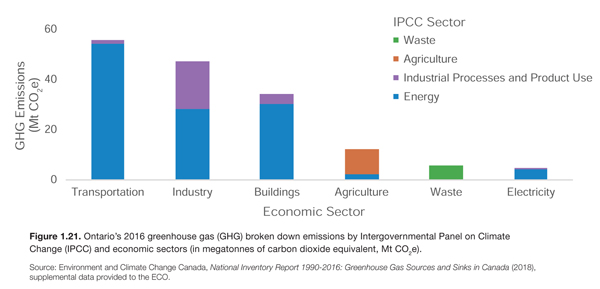Ontario must have a climate change law that drives down emissions while funding sensible solutions, says a September 25 report from Dianne Saxe, Environmental Commissioner of Ontario.
 Climate Action in Ontario: What’s Next? shows how Ontario’s greenhouse gas (GHG) emissions went down from 2005 to 2016. But the government’s recent halt to climate programs could reverse that trend, and throw away the lowest cost pathways to a sustainable economy, the report says.
Climate Action in Ontario: What’s Next? shows how Ontario’s greenhouse gas (GHG) emissions went down from 2005 to 2016. But the government’s recent halt to climate programs could reverse that trend, and throw away the lowest cost pathways to a sustainable economy, the report says.
“Ontario has gutted most of its climate change programs,” said Saxe. These programs were starting to bring Ontario many benefits, the report shows. “Most of the cap and trade money was funding energy efficiency programs in Ontario communities – in schools, public housing, transit and hospitals, for example – that would have reduced GHGs and saved millions of dollars in energy costs.”
“Dismantling a climate change law that was working is bad for our environment, bad for our health, and bad for business,” said Saxe.
 “The Cap and Trade Cancellation Act, the government’s proposed replacement climate law, is much too weak,” said Saxe. “A meaningful climate law needs science-based emissions budgets, a legal obligation to stay within those budgets, and credible, transparent progress reporting. Ontario can still choose sensible solutions that help families make ends meet while bringing climate pollution down. Polluter-pay tools, for example, give people more choice and a fair reward for reducing their emissions, and can help reduce other taxes they pay,” she said.
“The Cap and Trade Cancellation Act, the government’s proposed replacement climate law, is much too weak,” said Saxe. “A meaningful climate law needs science-based emissions budgets, a legal obligation to stay within those budgets, and credible, transparent progress reporting. Ontario can still choose sensible solutions that help families make ends meet while bringing climate pollution down. Polluter-pay tools, for example, give people more choice and a fair reward for reducing their emissions, and can help reduce other taxes they pay,” she said.
The Cap and Trade Cancellation Act (Bill 4) is posted for public comment on Ontario’s Environmental Registry. Saxe encouraged all Ontarians to comment on the proposal by the October 11 deadline.
Saxe also reports that the government is not getting ready for the climate change impacts that Ontarians are starting to see. Extreme weather didn’t start with climate change, but climate change means that we can expect wilder, warmer weather – stronger storms and heavier flooding, punishing heat waves, and more health risks. Government-funded infrastructure is being built for a climate that no longer exists, she says. And up to 10 per cent of Canadian properties may soon be too high risk for private sector insurance if measures aren’t taken to lower flood risk.
